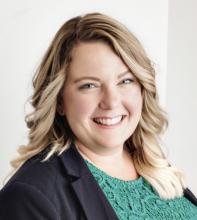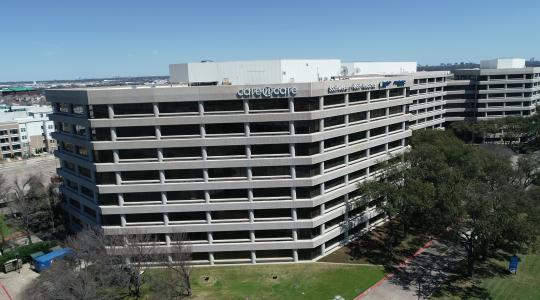Post-acute care is a critical component of healthcare outcomes as it promotes functional recovery for (primarily older) adults, helps prevent unnecessary hospital admission or readmissions, and can address care gaps, helping patients avoid premature admission to long-term care facilities.

Dir. of Care Transitions
Within the SWHR network, post-acute care may include a skilled nursing facility (SNF), home health or hospice care, as well as long-term care hospitals and in-patient rehabilitation facilities.
Jennifer Young, RN, is the Director of Care Transitions for Texas Health Alliance an acute care hospital in Fort Worth. Her team is responsible for the discharge and transfer of patients from the hospital to post-acute care facilities. She also ensures connections are maintained with a patient’s Primary Care Provider.
Delivering 360 degrees of care
“Open and honest communication between the hospital and our partners at a post-acute care facility – often a skilled nursing facility (SNF) – is essential to building trust, driving quality and ensuring 360 degrees of care,” explains Jennifer.
“I’m a firm believer in building relationships. When you know someone, you can more easily interact on both the simple tasks and the tough challenges and maintain trust,” she says. “Our team’s objective is to set up the patient for success, creating a positive transition to a new care facility. By having a relationship and building trust, we know that if we receive a “no” in response to our post-acute outreach, it’s because that facility is not the right place for our patient. We strive to be solution-focused and collaborative. Sometimes “no” is the right answer. If a facility doesn’t have the range of services a patient needs, we need to know that to ensure a positive care experience. Clear communication is vital.”
Kim Neathery, BSN, RN, is a Manager of Complex Case Management for Southwestern Health Resources in the Care Transformation and Innovation department. “One of the ways SWHR supports the transition between acute and post-acute care is by thoroughly vetting and curating area facilities and sharing a tiered provider list with key stakeholders in our clinically integrated network. This valuable quality-driven information helps them make informed decisions,” she explains.
Conveying medical history is critical
“Not all communication is equal,” says Jennifer, addressing the topic of patients who present to the emergency department. “Understanding a patient’s previous clinical history creates a bridge of knowledge that helps our care team understand where someone is truly at, so we can successfully move that person to a higher level of health.”
In her role, many of the individuals she encounters are senior members of the population. “Elderly patients don’t always have the ability to communicate on their own behalf,” she explains. “I’m sympathetic to any senior who is altered or experiencing impaired mental status due to a stroke, for example. If we have documentation of previous care – a medication list, recent progress notes – this can be huge in helping ensure a positive next step in their care journey. It’s challenging to make swift decisions when you don’t have all the necessary information.
Physician involvement supports success
“Several years ago, we started inviting physicians to send the SNF a secure text message report for patients transferring from acute to post-acute care. When physicians at both ends of a patient exchange are involved, it can smooth the path, expediting beneficial solutions and creating alignment around next steps,” says Jennifer.
“For some of our most trusted physicians, they have a holistic grasp of the unique health needs of their elderly patients and can be a reassuring factor in successfully transitioning someone to post-acute care, assisting with complex communication needs,” she confirms.
Understanding clinical capabilities matters
“When we’re transitioning a patient, we want to make sure we’re creating a good match between the individual and the care facility. If a care facility is not transparent, we might refer a patient whose needs are outside the realm of their capabilities. This creates a potential readmission problem and a patient satisfaction problem,” explains Jennifer. “We really need our post-acute partners not to say “yes” to a request if they’re unable to care for a complex patient. Finding the right fit matters to creating a good outcome. At the same time, we want to do everything we can on our end to support a facility so they’re in a future position to say “yes” with confidence.”
Kim points to the value of Joint Operating Committee meetings (JOCs) to connect providers and post-acute care destinations. “These conversations support collaboration, helping ensure we’re providing the best possible care for our members,” she says. “Even virtual meetings represent an opportunity to build bridges, understand the challenges different groups are facing and get to know one another.” Currently Southwestern Health Resources conducts JOCs between SWHR employees and PAC partners and then brings this information to JOCs between SWHR team members, hospitals and physicians within the network. Finally, SWHR has begun conducting JOCs directly between hospitals, physicians and PAC providers. The goal is to build great communication and, ultimately, help the patient have the best experience within the continuum of care.
Final thoughts
“The vision of achieving one care team is foundational for us,” says Jennifer. “We’re mindful of the need to be less siloed. It can be challenging in a post-COVID world to connect with another care team member in a meaningful way that will support success. When it works – when we have a sense of camaraderie and an easy flow of communication – that’s when healthcare is truly working in the interests of both the care recipient and the caregiver.
“We look for opportunities to support each other, to be mindful. If a care team member prefers one channel of communication over another, we work with that information. How can I help you do your job so I can do mine? Working together, how can we move the needle for this individual who needs care? Life happens 24/7. We are building a community and we are using the awesome technology at our fingertips to create vibrancy around our partnerships. We all benefit.”
“SWHR has multiple departments who assist stakeholders during a member’s hospitalization as well as upon discharging home, coordinating between teams, and ensuring that we’re helping to find those “right places” and make care connections,” adds Kim.
She agrees good communication is critical.
“Recently, we had a situation where a hospital’s Care Transition Manager was struggling to transition a discharged patient into palliative care and a lack of transparent communication had created a delay. As soon as SWHR learned one of our network’s managed Medicare members needed palliative care – and wasn’t receiving it – we swung into action, working with the hospital, the primary care physician, getting our CTI multidisciplinary care team involved, and connecting with the family. Two days later, the member was receiving the palliative care his physician had recommended for him and family members were feeling supported. It’s rewarding when we can lift a burden off someone else’s shoulders and close a care gap,” Kim says. “Jennifer’s description of “one care team” aligns absolutely with the SWHR mission. We’re all about providing full circle support at every level and building a better way to care, together.”



